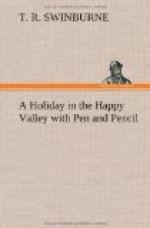Each of the party provided him or herself with a khudstick, consisting of a strong and tough shaft about five feet long, tapering slightly towards the base, where it is shod with a chisel-shaped iron end.
Our staff of retainers had now been brought up to five—the shikari, Ahmed Bot, having procured a satellite, known as the chota shikari, a youth of not unprepossessing appearance, but whose necessity in our scheme of existence I had not quite determined. Ahmed Bot, however, was of opinion that all sahibs who wanted sport required two shikaris, so I imagined that while I was to be engaged with one in pursuit of bara singh, the other would employ himself in “rounding up” a few tigers for the next day’s sport in another direction. Ahmed Bot agreed with me in the main, but did not feel at all sure about the tigers—he proposed ibex.
The fifth wheel to our coach was a strikingly ugly person, like a hippopotamus, whose plainness was not diminished by a pair of enormous goggles; this was the harmless necessary sweeper, that pariah among domestics, whose usefulness is undreamed of out of India.
After dinner last night we left the hotel, truly thankful to shake the dust of its gloomy precincts from our feet, and sought our boats, which were moored in the Chenar Bagh. How snug and bright the “ship” seemed after the murky corridors of Nedou! And yet the Cruiser was not much to boast of, really, in the way of luxury.
Let me describe a typical boarded dounga. Upon a long, low, flat-bottomed hull, which tapered to a sharp point at bow and stern, was raised a light wooden superstructure with a flat roof, upon which the passengers could sit. The interior was divided off into some half-a-dozen compartments, a vestibule or outer cabin held boxes, &c., and through it one passed into the dining or parlour cabin, which opened again to two little bedrooms and a couple of bathrooms. There was no furniture to speak of, but we had hired from Cockburn all that we required for the trip.
The servants, as well as the crew of the dounga, were all stowed in a “tender” known as the cook boat—no one, except for navigating duties, having any business on board the “flagship.”
Charlotte Smithson had a smaller ship than ours—a light wooden frame, which supported movable matting screens or curtains, taking the place of our wooden cabins. The matted dounga looked as though it might be chilly, particularly if a strong wind came to play among the rather draughty-looking mats which were all that our poor friend had between her and a cold world!




